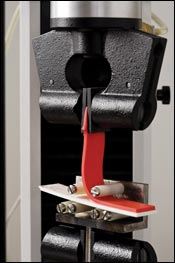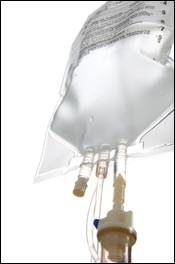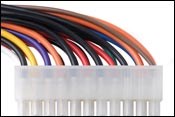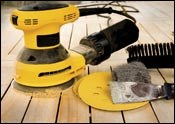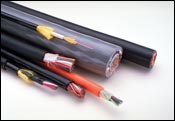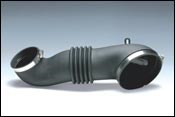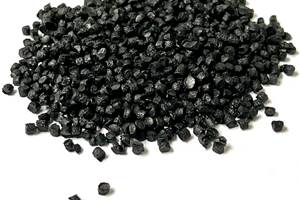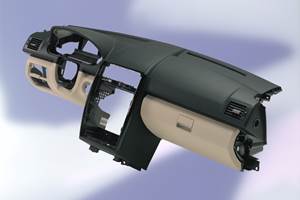TPEs Move Up the Performance Scale
This first of two articles on directions in TPE development focuses on styrenic, copolyester, polyamide, and TP urethane elastomers. The following article covers olefinics—TPOs, TPVs, and POEs.
The ability of thermoplastic elastomers to process like thermoplastics and imitate the performance and feel of thermoset rubbers has made them stars among plastic materials over the last 10 years. Speedier processing and lower scrap rates have earned TPEs market niches that continue to expand in consumer, medical, and automotive markets. Hard-soft overmolding has become commonplace, a design trend adopted worldwide for products from toothbrushes to power tools.
TPEs have been one of the most active areas in materials and application development. A 2007 market study by Freedonia Group forecasts 6.3% annual growth in world demand for all TPEs through 2011, reaching nearly 8.1 billion lb. Automotive remains the largest consumer of TPEs worldwide, accounting for 40% to 50% of the total, according to consultant Robert Eller, president of Robert Eller Associates.
However, in developed countries, most of the easy substitutions for thermoset rubber have been done and demand is slowing. There are signs of commoditization in areas like consumer and building/construction, and the overall market is shifting primarily to China, where many products made of TPEs are now being manufactured. These include footwear, housewares, consumer products, appliances, tools, and sports/leisure products, notes Eller.
TPE suppliers are responding with higher-performing materials and extended functionality. “Until now, TPEs were considered primarily just accessories, providing feel, look, and color,” says Walt Ripple, v.p. of marketing for GLS (recently acquired by PolyOne). “That’s not the case anymore. These materials are bringing a full breadth of new performance.”
FOCUS ON SPECIALTIES
TPEs nowadays are being targeted for applications higher on the performance ladder. For example, styrenic TPEs such as SEBS have joined TPO in replacing copolyester elastomer (COPE) TPEs in more highly engineered applications like airbag covers. Similarly, styrenic TPEs are increasingly being used to replace more costly TPUs in abrasion-resistant applications.
Specialty TPE grades are emerging with greater transparency, lower hardness, chemical resistance, and scratch and mar resistance. The “greening” of plastics is also having an impact as bets are being placed on biobased or “renewable-content” materials. Higher-heat materials are also being developed for very small and tightly packaged applications in wire and cable and automotive. Overmold bondability to other thermoplastics, textiles, and metals remains a focus of R&D. Regulatory and market demands are also forcing suppliers to develop new materials without halogenated flame retardants and with lower volatile emissions (auto fogging).
BIOBASED TPEs EMERGE
TPE suppliers believe biobased content will play a growing role in the material selection process for future applications. The K 2007 show in Dusseldorf saw several new TPEs made from chemical building blocks obtained from biological or agricultural sources rather than fossil hydrocarbons.
For example, Spain’s Merquinsa introduced the world’s first TPUs derived from biobased materials. Pearlthane Eco and Pearlbond Eco are made with polyols from vegetable oils and fatty acids. A new plant in Barcelona is producing one commercial injection grade with 95 Shore A durometer. Four more injection and extrusion grades from 70 Shore A to 65 D are expected in the second half. Renewable content is 60% to 75% by weight and performance is said to be equal to, or better than, standard TPUs.
A biobased TPU from GLS, called OnFlex U, comes from soybean oils. Renewable content is claimed to be 30% to 45% and hardness ranges from 65 to 95 Shore A. Performance is similar to traditional grades for markets like medical, consumer, and industrial.
Also at K 2007, Arkema unveiled the industry’s first commercial engineering TPE made from renewable resources. Pebax Rnew is a polyether-block-amide (PEBA) made with Arkema’s Rilsan nylon 11, based on castor oil. Grades have 20% to 90% renewable content and Shore hardness from 25 D to 72 D for electronics, athletic shoes, and automotive uses.
EMS-Grivory’s expanded Grilflex PEBA line includes bio-based materials with 10% to 100% renewable content. The nylon 12-based materials, based on castor and canola oil, have properties similar to standard Grilflex and are targeted for sporting goods.
The first copolyester TPE with renewable content is expected from DuPont later this year. Hytrel RS grades will be made of Cerenol polyols derived from propanediol (PDO) obtained from bacterial fermentation of corn sugar.
OVERMOLDING ADVANCES
After extensive development and validation of TPEs with improved bonding to a range of materials, hard-soft overmolding is poised for even greater use, suppliers say. “Now the ball is in the court of the designer to consider the options and use the products,” says Jonas Angus, president of TPE Solutions. Suppliers are breaking new ground, like coming out with the first soft material that bonds to polysulfone (PSU) for medical applications. Softlink 141A is a custom-formulated styrenic from TPE Solutions that adheres to PSU and withstands autoclave sterilization.
A brand-new line of SEBS grades from Elastocon TPE Technologies is suitable for overmolding on PC, ABS, PC/ABS, nylon, HIPS, and copolyesters. Elastocon STK materials of 50 to 70 Shore A are designed for tool and hardware grips, housewares, personal-care products, and toys. The company’s existing 2800/8000 series bonds to PP.
Multibase has introduced new Multiflex TEA alloys that provide improved bondability to engineering thermoplastics. Also in the pipeline at Multibase are improved weathering grades (withstanding up to 4000 kJ accelerated exposure) for auto exterior uses. For interior applications, the company is focused on new grades that provide fogging resistance at up to 110 C/230 F, suntan-oil resistance, and improved gas-fading resistance.
RTP 6042, a new series of TPEs for overmolding from RTP Co., is reportedly more process-friendly and competitively priced than standard TPEs. It bonds to PC, ABS, PC/ABS, and PC/acrylic.
Transparent TPEs are in greater demand for enhanced design flexibility in a range of overmolding applications, according to Kraiburg TPE Corp. This supplier has launched new Thermolast K grades of translucent SEBS-based TPEs that boast a previously unattainable level of adhesion to PC and ABS. They also bond to other styrenics, PBT, acrylic, and PETG. Hardnesses are 50 A to 80 A.
Heat resistance has been extended with new Thermolast V SEBS compounds that have a service temperature of 140 C/284 F for industrial and auto underhood parts.
STYRENICS GO UP-MARKET
Suppliers say the shift of the footwear market to China has caused commoditization of SBS materials. Even hydrogenated SEBS, a higher-value product, is fighting such pressures, according to Sachin Sakhalkar, new business development manager for Teknor Apex Co. “To maintain business in the U.S. you have to go after up-market applications, go after TPU and copolyesters, ” he asserts. Other opportunities include non-halogenated FR materials and plasticizer-free PVC replacements.
Teknor’s new Elexar EL1402 family of non-halogenated SEBS grades meet UL 94V-0 with hardness starting at 50 A for wire/cable and molding. New value-added SEBS grades include Monprene MP1871R to replace silicone in medical tubing and MP2295 to replace latex in films.
The focus on specialties is evident at Kraton Polymers, maker of styrenic block copolymers (SBCs). It developed high-heat grades to replace thermoset rubber and olefinic TPVs. Its most recent SBC improves compression set of styrenic TPEs above 70 C (158 F). Kraton G1633 has 50% higher molecular weight than standard SBCs. Styrenic TPEs made of G1633 have compression set approaching that of some TPVs. Uses include auto weather seals and medical stoppers.
Kraton is also commercializing an SEBS medical grade that will be its softest material yet. The 35 A grade, Kraton MD6945, is clear and tough and offers easy processing in blown and cast films. It can be blended with PP for high clarity and replaces PVC in IV bags, IV drug-delivery systems, ostomy bags, and medical tubing. Also in development is a modified SEBS that provides barrier resistance in ion-exchange membranes for water-purification systems.
Kuraray America’s Septon business unit has commercialized an isoprene-based styrenic TPE that competes with TPUs and COPEs. Septon Q boasts a service temperature 10° higher than standard Septon along with good tear strength and higher modulus. The 70 A grade reportedly has abrasion and scratch resistance that rivals TPU, as well as lower density. Applications include sporting goods, wire coating, tubing, and auto instrument-panel (IP) skins.
New TPE alloys are finding a place in auto interiors. A. Schulman unveiled a licensed technology for Inteva Products (formerly Delphi Interiors & Closures), which consists of a hybrid TPE for slush molding IP skins to replace slush-molded TPU or sprayed urethane. The styrenic/olefinic alloy has lower density than TPU and is reportedly comparable in scratch and abrasion resistance and weatherability. Schulman is working with Inteva on commercial applications for 2010 models.
A Schulman styrenic alloy called Sumiflex is based on technology licensed from Mitsubishi Chemical. It offers lower specific gravity, improved weatherability, high scratch/mar resistance, and lower cost vs. aliphatic TPU in auto knobs and handles.
AlphaGary’s new Evoprene HP series includes SEBS grades with improved abrasion resistance and strength. A vibration-dampening Evoprene grade has a lower filler level. Also new is a 50 Shore A Evoprene oil-free SEBS for food-contact seals that boasts excellent recovery properties.
To meet the demand for halogen-free FR materials, GLS recently launched a SEBS-based line called OnFlex-S HF. It meets UL 94V-0 and comes in a wide range of hardnesses. Injection and blow molded versions are aimed at seals for electrical junction boxes and cable jacketing.
MORE SPECIALTIES
Non-halogenated versions of Alcryn, a partially crosslinked, chlorinated ethylene-copolymer alloy, have been launched by Advanced Polymer Alloys, div. of Ferro Corp. They are targeted for wire and cable in Europe and Asia, where Alcryn is offered as a phthalate-free alternative to PVC.
Replacing PVC containing phthalates is also the target for a new TPE alloy from GLS. Versaflex CL E95 offers water clarity, sterilizeability, and low extractables. It’s for medical tubing, drug storage and delivery devices, face masks, and infant-care items.
GLS has also come out with one of the first high-specific-gravity TPE compounds. Gravitech TPE alloy for injection molding and sheet extrusion has specific gravity from 2 to 11. The first commercial application is a dental x-ray shield.
GLS says new Versaflex TPE alloys are also being developed for barrier applications like medical stoppers, syringe tips, and food liners. Injection molding and extrusion grades are currently being sampled.
Kuraray has built a pilot plant in Japan for an entirely new all-acrylic TPE. It consists of alternating hard blocks of PMMA and soft blocks of poly-n-butyl-acrylate. It is said to offer weatherability, transparency, softness, and good adhesion to polar resins and paint. Hardness is 30 Shore A to 60 D. It can be injection molded, slush molded, and extruded into sheet and film. Sony has used it in camera grips. Other markets are consumer and sporting goods, automotive, and optical films.
Silicone rubber has entered the TPE arena in two forms. One is the rubber phase in novel “engineering” TPVs (see below). The other is the soft segment (more than 90% of the composition) in a silicone-urea copolymer called Geniomer, introduced by Wacker Chemie of Germany in 2004 (see Learn More). It forms crosslinks when it cools from the melt, though the bonds are reversible when remelted.
Geniomer is clear and has chemical purity suitable for medical uses, according to Wacker. It has silicone characteristics of good slip and release properties, UV resistance, and gas permeability. It is also paintable and can bond plastics to glass or metal. Geniomer has commercial uses as a heat-sink material in electronics and an encapsulant for solar and photovoltaic components. It has also been approved for a coextruded polyolefin release film.
TPUS GET SOFTER
Considerable development work in TPUs is focused on softer and more heat-resistant materials. The goal is boosting continuous-use temperature from the current 135 C to 150 C. Another key goal is replacing phthalate-plasticized PVC with grades as soft as 52 Shore A, notes Stephane Morin, BASF sales and product manager.
There are also development efforts in aliphatic TPUs, a category that is not widely used in North America. These materials have greater abrasion and weather resistance than aromatic TPUs for automotive interiors but cost almost twice as much. For example, Bayer MaterialScience is working on improved aliphatic weathering grades for uses such as solar cells.
Merquinsa’s R&D is focused on specialty aliphatic TPUs. The company has started to make aliphatics via a continuous process instead of a batch method for better quality and reliability.
Another interesting trend is the modification of TPU with styrenic TPEs like SIBS—a relatively new styrenic type (see Learn More). TPU compounder Arkadia Plastics has developed the Ark 2100 series, a polyester TPU/SIBS alloy utilizing Sibstar SIBS from Kaneka. The 40 to 60 Shore A grades offer low compression set in sporting goods, footwear, and tubing.
At the K 2007 show in Germany, BASF’s Elastogran subsidiary announced the first crosslinked TPU (or TPU-X), called Elastollan X-Flex. Addition of a proprietary liquid prepolymer mixture to a specially modified Elastollan TPU produces reversible crosslinks that “set” when the material cools after molding but unlink when the product is remelted. The result is enhanced compression-set and vibration-dampening properties similar to those of thermoset rubber, plus better resistance to ozone, oils, and greases. The 60 A elastomer withstands long-term use at 120 C/250 F and short-term peaks at 150 C/300 F (see Learn More).
In wire and cable, TPU suppliers note that jacketing now requires more durability and heat resistance due to the smaller wires, tighter packing, and higher heat generated in the cable. There is also a need for TPUs with improved chemical resistance, specifically to high-ethanol E85 fuel. Lubrizol has developed two ester-based extrusion grades for hose and tubing. Estane X-1351 is a 95 A TPU that provides up to 80% lower E85 permeability than similar ester grades. Estane X-1352 is a 62 Shore D TPU with up to 95% lower E85 permeability. These grades are also more resistant to jet fuel, diesel, and biodiesel.
Lubrizol claims to have set a new benchmark for flame resistance in non-halogen FR TPUs for wire/cable jacketing with its Estane ZHF95AT3. This 95 A polyether meets UL 94V-0 and has a Limiting Oxygen Index above 35, compared with the typical 25 LOI for other non-halogen FR TPUs. This product is said to meet higher FR specs, such as the IEC 60332-3 cable-tray test.
New TPUs with softer feel are slated for commercialization later this year by Bayer MaterialScience. They are for auto interiors, especially IPs, and possibly for furniture.
Bayer also recently introduced medical grades with improved chemical resistance. Desmopan DP 2590A is a 90 A ester for blown film, and Desmopan DP 9370A is a 70 A ether (Bayer’s softest medical grade) for tubing and grips. Also new is Texin 285, an 85A ester for medical injection and extrusion. It is aimed at wound dressings, fabric coatings, tubing, grips, and packaging.
Sartomer Co. Inc. has expanded the range of its unique polybutadiene-based TPUs, which have greater resistance to strong acids and bases. They also offer barrier to oxygen and moisture plus unusual electrical properties. A brand-new grade is Poly bd 7840, which can be dissolved in solvents and compounded in rubber. Targets uses include barrier layers, hose and tubing, wire and cable, footwear, film, sheet, and adhesives.
Dow is working on soft TPUs in the 45 to 55 A range as replacements for lower-end TPEs in footwear, wire/cable, and consumer goods. And new higher-performing TPUs from Dow include a family of Pellethane ethers and esters with low yellowness index. Dow says these “low-YI” products will facilitate greater color consistency. Other advantages include better weatherability, cost savings due to reduced need for uv stabilizers, and improved thermal stability for high-heat and regrind applications.
Dow also has a new calendering grade for conveyor belts, sewer liners, fabrics, and nonwovens.
Ovation Polymers is a relatively new specialty compounder offering TPU alloyed with SEBS or other styrenic TPEs. (TPU/olefinic blends are also envisioned.) Reactive extrusion technology is said to extend the softness range without oils or plasticizers while retaining tear strength, compression set, and hydrolytic resistance. Among its newest products is Softaplas S56A alloy for swimming-pool and bathtub fixtures, appliances, and lawn/garden tools.
Ovation also has Softaplas R TPUs with short or long glass or carbon fiber. New Optestat TPE compounds contain carbon nanotubes for ESD applications. A TPU version is aimed at components for electronics, business machines, tools, and electrical assemblies.
NYLON-BASED TPEs
Nylon Corp. of America (Nycoa) is looking to boost performance of its Nycolastic nylon-copolymer TPEs. Based on nylon 6 and 66, they reportedly provide better chemical and heat resistance than COPE and polyester/nylon elastomers. Nycoa is looking to go softer—down from the current 40 Shore D to the teens—for overmolding onto other nylons. Another goal is improved hysteresis for applications like gaskets.
Likewise, Arkema is developing ultrasoft grades of its Pebax polyether-block-amides (PEBAs) down to 75 Shore A for sporting goods and running shoes. It is also working on breathable film grades with high moisture-vapor transmission and chemical resistance for military and outdoor apparel.
At the same time, Arkema is developing harder nylon-12-based Pebax grades with flat hysteresis (50,000 psi flex modulus) and low energy absorption for medical catheters, thin tubing, and ski bindings.
EMS-Grivory has expanded its own PEBA line, now called Grilflex. The materials, based on nylon 6 or 12, boast better hydrolysis resistance and dimensional stability than previous grades and 20% lower density than TPUs and other TPEs. Nylon 12 grades have hardness of 36 to 70 D for sporting goods and 50 to 60 D for medical tubing.
A new PEBA for athletic footwear from Evonik Degussa bonds to ester-based TPUs without an adhesive. The Vestamid E grade has low gel content and ranges from 40 A to 62 D. The company is working on harder grades for added scratch and abrasion resistance in outdoor sports applications.
UPGRADED COPOLYESTERS
Higher-performing COPE materials are finding expanded use beyond their core applications such as automotive CVJ boots and airbag covers. New materials development has been spurred by the fact that COPE lost its dominant position in airbag covers to TPO and TPVs due to eased requirements for cold impact.
DSM Engineering Plastics launched non-halogenated Arnitel XG as an alternative to PVC for cable insulation in consumer electronics. It reportedly meets the UL VW1 spec.
Another new introduction from DSM raises the heat-aging performance of Arnitel for wire and cable. Non-halogenated Arnitel C has a continuous-use rating of 3000 hr at 175 C and is claimed to be the first COPE that meets ISO 6722 Class D temperature requirements. It also provides hydrolysis resistance (>150 days in 85 C water) and abrasion resistance (five times greater than ETFE or crosslinked PE in the needle test).
DSM Biomedical in the Netherlands recently started to develop COPE grades for orthopedic devices. COPE offers resistance to wear and fatigue, DSM says.
Ticona is developing some of the industry’s first UV-stable COPE products for office furniture, auto interiors, and monofilaments. Up to four grades are slated for launch later this year, including Riteflex 655UVLM, which is already used in laser-markable animal tags. Injection molding and extrusion grades will run 25 to 72 D.
Hytrel 5555 HS COPE from DuPont has earned a UL 758 listing (up to 105 and 600 V), which allows wire makers to obtain approval in a matter of weeks. It has better tensile and elongation properties than flexible PVC and its thin-wall capabilities make it a cost-saving alternative to PVC, DuPont says.
Eastman is working on a new Neostar copolyester-ether TPE with improved bondability and greater heat resistance for building and construction. The prototype has 75 Shore A hardness and flex modulus of 12,000 psi. It bonds to other copolyesters, PVC, urethanes, and some styrenics. Eastman’s Ecdel medical-grade copolyester-ether is now being aimed at clear multilayer form-fill-seal medical-device packaging. Non-medical applications are also being explored.
RTP has developed new conductive copolyesters for auto fuel-systems. They are formulated to maintain base-resin properties and minimize loss of elongation.
A new compounder, Ovation Polymers, produces Zhutrex COPE alloys and blends of 45 to 75 D in an extruder. They can be formulated for improved flexibility or hardness and chemical and heat resistance. Uses include auto underhood parts, applicances, and sporting goods.
‘SUPER-TPVS’ FIND NICHE
Only a few years old, the emerging category of so-called “super-TPVs” or “engineering TPVs” (ETPVs), is pushing the limits of heat and oil resistance. Unlike conventional thermoplastic vulcanizates, which combine a PP matrix and a vulcanized EPDM rubber phase (see next article), ETPVs have an engineering thermoplastic matrix and a higher-performance rubber phase.
For example, Zeon Chemicals’ Zeotherm combines a nylon 6 matrix with a crosslinked polyacrylate (ACM) rubber. Zeon is developing new grades that withstand repeated heat exposure up to 175 C/347 F and short-term exposure up to 190 C/374 F. New auto emissions controls have prompted development of Zeotherm grades with greater resistance to acid condensate generated from the increased recirculation of exhaust gases back into the engine.
High heat resistance is also an advantage of DuPont’s ETPV family with a copolyester matrix and a highly crosslinked AEM rubber (modified ethylene-acrylate). They handle 135 C/275 F and a peak of 180 C/356 F. New grades are being developed for wire/cable, hose, and tubing. DuPont introduced two grades boasting excellent processability in profile extrusion and blow molding. One is a black heat-stabilized version rated for 3000 hr at 150 C/302 F and the other is a standard natural grade for shorter term requirements.
An ETPV from Multibase consists of crosslinked silicone in a nylon or TPU matrix. In overmolded electronic devices it provides improved durability, weatherability, and scratch resistance, along with a soft, silky touch. Recent variations of this “thermoplastic silicone vulcanizate” (TPSiV) family include injection and extrusion grades with a PP matrix. They are said to offer excellent creep resistance at up to 120 C/248 F for auto interiors, plumbing, and soft-touch PP parts.
Meanwhile, another class of TPV fills a mid-range performance level. These retain PP as the matrix but incorporate a hydrogenated SBC as the vulcanized rubber segment. Teknor Apex says its Uniprene XL has superior long-term elastic recovery, improved resistance to hot oils and solvents, and greater tensile strength than conventional TPVs. Teknor Apex is working to raise its heat resistance from 125 C to 150 C.
Related Content
TPE Made with 50% PCR Derived from End-of-Life Tires
Prism Worldwide has commercialized its first TPE with this type of recycled content based on its patented technology.
Read MoreHybrid EPDM-TPE Adhesion Compounds for Automotive Industry
Kraiburg’s new compounds targeted to auto sealing and exterior sector applications and toolmakers.
Read MoreThermoplastic Elastomers With Recycled Content for Automotive Applications
Avient announced new grades of TPE to meet demand for recycled content.
Read MoreTracing the History of Polymeric Materials -- Part 29: Polyurethane
This material family has unparalleled versatility, not only in terms of the forms the material can take, but in the different ways in which it can be processed.
Read MoreRead Next
K 2004 Wrap-Up on Materials: Setting New Benchmarks for Processability and Performance
Higher flow, higher heat, higher barrier, higher clarity, higher stiffness, lower durometer, lower smoke, lower odor—materials exhibits at the recent K 2004 show in Dusseldorf were stretching the bounds of processing and performance properties in all directions.
Read MoreLead the Conversation, Change the Conversation
Coverage of single-use plastics can be both misleading and demoralizing. Here are 10 tips for changing the perception of the plastics industry at your company and in your community.
Read MorePeople 4.0 – How to Get Buy-In from Your Staff for Industry 4.0 Systems
Implementing a production monitoring system as the foundation of a ‘smart factory’ is about integrating people with new technology as much as it is about integrating machines and computers. Here are tips from a company that has gone through the process.
Read More



